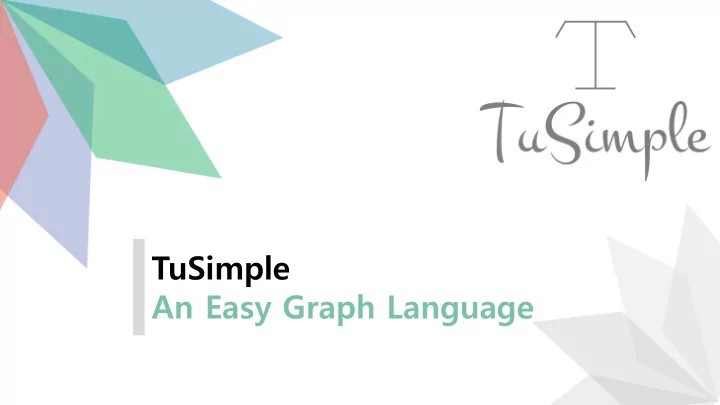

TuSimple An Easy Graph Language
The Team Jihao Zhang Manager Zicheng Xu Language Guru Shen Zhu System Architect Ziyi Mu Language Guru & Architect Yunzi Chai Tester
Overview The TuSimple language is designed to make coding graphs as simple as drawing graphs on paper. Problem Graphs has important applications in networking, bioinformatics, sof tware engineering, database and web design, machine learning, and other technical domains. It's a pain to draw graphs and calculate graph algorithms by hand. It's messy, time consuming and usually results in wrong answers. It’s also hard to programming graphs with programming languages l ike C/C++, Java, etc.
Overview The TuSimple language is designed to make representing and calculating graphs as simple as possible. Solution Intuitive syntax to initialize graphs and graph components. A lot of built-in functions to manipulate complex graphs. User-friendly built-in containers. Familiar syntax.
Project status 1922 lines of OCaml code 2486 lines of C code 277 git commits 70 test cases 2083 lines of test code
Architecture Source input.ll file Code(input.tu) Code Scanner generation Semantic Parser Checker
Architecture input.ll External Libraries(Set, Hashmap, etc.) Assembler utils.o input.s Linker ./compile.sh <code> executable file
A Sneak Peak - Syntax Declare container types int main(){ node@{int} node1, node2, node3; list@{node@{int}} lst; map@{int, node@{int}} mp; set@{string} s; graph gp; Initialize containers and graph components new s; new node1; new node2; new node3; new node4; new lst; new gp; new s; new mp; node1 -> node2 = 2; Connect nodes and initialize edge weights. node2 -> @{node1, node3, node4} = @{2, 4, 8}; node1.setValue(1); lst += @{node1, node2}; lst++; Overload operators node1 = lst[0]; s += @{”tusimple”, ”is”, “so”, “great”}; }
Language Features Operators Type Comments + - * / % and Containers // this is a comment += -= = int == && || ! float /* >= <= string so does this -> -- graph */ ++ bool node@{type} list@{type} map@{type, type} set@{type}
Built-in Functions List Node Graph get(pos) value() bfs(startingNode) pop() name() dfs(startingNode) length() length() relax() remove(pos) setvalue(value) expand() concat(anotherList) combine(anotherGraph) iterNode(pos) printList() iterGraph(pos) weightIter(pos) init() addNode(node) addEdge(node, node, weight) Map printGraph() Set get(key) put(element) put(key, value) length() size() contain(element) haskey(key) remove(element) remove(key)
Graph depth-first search S c a b node@{int} s, a, b, c, d; graph g; list@{int} lst; d new s; new a; new b; new c; new d; new lst; s -- {a , b , c} = {1, 1, 1}; d -- {a , b, c} = {1, 1, 1}; lst = g.dfs(s); lst.printList(); // output: s a d b c
Graph relaxation In shortest path algorithms (Bellman-Ford, Dijkstra's), relaxation is an important operation. Edge relaxation . To relax an edge v->w means to test whether the best known way from s to w is to go from s to v, then take the edge from v to w, and, if so, update our data structures. Vertex relaxation. Relax all the edges pointing from a given vertex. Java TuSimple g.relax(v)
Automated tests We started from MicroC, then added a test for each feature we add. 70 test cases, 26 for should-fail, 44 for should-pass Use shell script to automate the process Verifies all the test cases are passed before committing
Automated tests
Demo Breadth-first search (BFS) Shortest path Neural network training
Demo Breadth-first search (BFS) from node 1 100 1 14 11 5 3 15 2 1 4 12 BFS result: node1 node2 node3 node5 node4
Demo Single source shortest path from node 1 3 1 0 1 1 3 2 1 3 1 2 3 3 4 2 4 1
Demo Neural networks training XOR function single hidden layer with three neurons Input Output (1, 1) 1 (0, 0) 0 (1, 0) 1 (0, 1) 1
Thank you Questions? Special Thanks to Julie, our TA, who continuously support our project.
Recommend
More recommend